Colloquia for Spring 2018
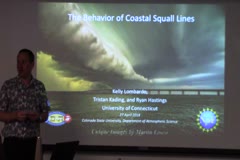
The Behavior of Coastal Squall Lines
April 27, 2018
Kelly Lombardo Visiting ATS from the University of Connecticut
Hosted by Michael Bell
Organized mesoscale convective systems, specifically quasi-linear convective systems (QLCS) or squall lines, respond to surface heterogeneities within coastal regions resulting from the presence of the marine atmospheric boundary layer (MABL) and complex elevated terrain. As organized storms move over and interact with these features, storm evolution, lifetime, mode, and severity are impacted.…
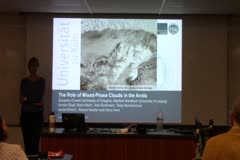
Arctic Amplification: The Role of Mixed-Phase Clouds
April 20, 2018
Susanne Crewell and Manfred Wendisch Visiting ATS from the University of Cologne and the University of Leipzig
Hosted by Christine Chiu
Within the last 25 years a remarkable increase of the Arctic near-surface air temperature exceeding the global warming by a factor of two to three has been observed. This phenomenon is commonly referred to as Arctic Amplification. The Arctic climate has several unique features, for example, the mostly low solar elevation, regularly occurring polar day and night, high surface albedo, large sea…
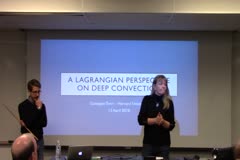
A Lagrangian view on precipitating convection
April 13, 2018
Giuseppe Torri Visiting ATS from Harvard
Hosted by Sue van den Heever
Because of the great societal impact that convective precipitation can have, producing accurate forecasts of convective systems and predicting how precipitation will respond to climate change are tasks of considerable importance. In order to accomplish such tasks, however, a robust, quantitative understanding of the dynamics of precipitating convective systems is first necessary. In this talk,…
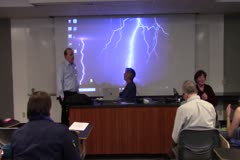
Marine Boundary Layers: OBSERVATIONS and Models
April 06, 2018
C.W. Fairall Visiting ATS from NOAA/ESRL
Hosted by Dave Randall
In this talk I will discuss the role of observations and models in studying atmospheric boundary processes. Observations play a crosscutting role in the context advancing the science of weather and climate. At a fundamental level, it is observations that can be used to develop a basic understanding of physical processes that must be modeled within the land-ocean-atmosphere system. Observations…
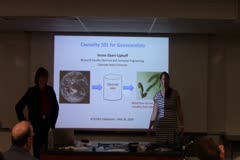
Causality 101 for Geoscientists
March 30, 2018
Imme Ebert-Uphoff Visiting ATS from CSU Department of Electrical and Computer Engineering
Hosted by Libby Barnes
This talk provides a basic introduction to the principles of causal discovery, i.e. the process of detecting potential cause-effect relationships from data. The primary goal is to teach the audience how to think about causality conceptually, and to provide an intuitive understanding of some of the opportunities and limitations of today's causal discovery methods. We introduce basic concepts,…
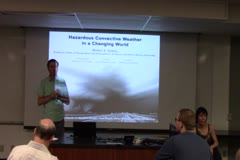
Hazardous Convective Weather in a Changing World
March 23, 2018
Walker Ashley, visiting ATS from Northern Illinois University
Hosted by Russ Schumacher
Recent extreme weather events reveal that we are increasingly vulnerable to weather hazards despite advances in science and technology. For instance, catastrophic tornadoes and tornado outbreaks in the past decade have produced tens of billions of dollars in damage and killed hundreds of people. When it comes to future disasters, will societal exposure overshadow potential climate…
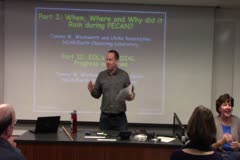
Part I: Where, When and Why did it Rain during PECAN? Part II: Overview of NCAR's Water Vapor DIAL
March 09, 2018
Tammy Weckwerth Visiting ATS from NCAR Earth Observing Laboratory
Hosted by Michael Bell
Part I: The 2015 Plains Elevated Convection At Night (PECAN) field campaign, based in Hays, KS, was designed to understand the causes of and improve the predictive skill of the central U.S. nocturnal precipitation maximum. Over 100 instruments were utilized to sample the pre-convective and convective conditions within and around unorganized storms and mesoscale convective systems. Multiple…
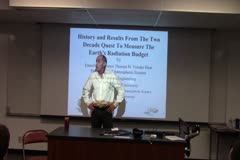
History and Results from the Two Decade Quest to Measure the Earth's Radiation Budget
March 02, 2018
Thomas H. Vonder Haar From ATS
Hosted by Chris Kummerow
The first global measurements of the Earth's emitted thermal energy and the amount of solar energy it absorbs from the sun were made from early satellites in the 1960s to the 1980s. They provided a much different Radiation Budget than had been thought in the pre-satellite era. Following the scientific method, two additional satellite missions were used to confirm the first measurements by…
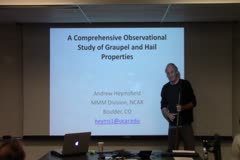
A Comprehensive Observational Study of Graupel and Hail Properties
February 09, 2018
Andrew Heymsfield
Hosted by Chris Kummerow
In this seminar, I will describe the general properties of graupel (rimed particles < 0.5 cm) and hail, based on observations. I will then report on my work that uses novel approaches to estimate the fall characteristics of hail. Three-dimensional volume scans of hailstones of sizes from 2 to 7 cm were printed in 3D models (I’ll show some in my seminar) using ABS plastic, and their…
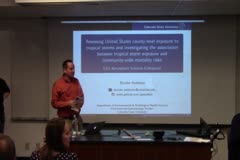
Assessing United States county-level exposure to tropical storms and investigating the association between tropical storm exposure and community-wide mortality risks
January 26, 2018
Brooke Anderson From CSU's Department of Environmental & Radiological Health Sciences
Hosted by Michael Bell
Hurricanes and tropical storms can cause substantial economic and human health impacts. These impacts occur through a number of hazard pathways, including severe winds, rain, flooding, and tornadoes. In the United States, hurricane impacts are often assessed at the county level, often the level at which health and economic data are available. I will describe results from assessing hurricane…
